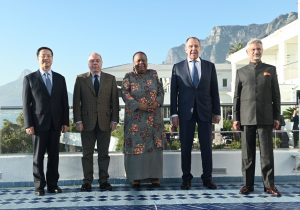In the current tumult of world politics, one would have expected BRICS (Brazil-Russia-India-China-South Africa) to follow the route of the South Asian Association for Regional Cooperation (SAARC), rather than the Quad route.
SAARC, for reference, has been defunct since its last meeting in 2014. The deadlock between India and Pakistan, the two main SAARC countries, sounded the death knell of the grouping.
The BRICS grouping is also full of contradictions. Brazil and India are on the same page regarding an expanded U.N. Security Council, but China opposes a permanent seat for India. South Africa, which is all set to host the next summit in Johannesburg, is required to arrest Russian President Vladimir Putin if he sets foot on South African soil under its ICC obligations. Not to mention the unresolved and increasingly sticky border dispute between India and China.
Yet, what seems to be happening makes BRICS quite the outlier. There is a rush to gain membership in BRICS. The intuitive aspect of this is the strength of BRICS economies and the opportunity to benefit from them, besides the kind of visibility that few plurilateral platforms enjoy. Many BRICS aspirants also realize that other groupings are closed to them, and do not want to miss an opportunity to hop on to the Global South bandwagon. Far from the twilight of BRICS, we are seeing the ingredients that make it ripe for rejuvenation.
Can India use this opportunity to advance its interests, or indeed hedge against the more unpalatable aspects of its relationship with the West?
From the Indian standpoint, this would entail being very clear about the length of the rope they cut China. Beijing’s strategic push in BRICS can be seen in moves like its attempt to lobby for a common currency for intra-BRICS trade. In a group containing Russia and China, this might be seen as “a direct economic challenge to the U.S.,” according to BRICS analyst William Gumede, associate professor at the School of Governance at Johannesburg’s University of the Witwatersrand. Furthermore, “de-dollarization” may not be an objective India currently wants to use the BRICS for, given Washington’s possible misgivings about such a move being spearheaded by the Sino-Russian combine. Besides, India will have its hands full warding off other sources of Chinese influence in the grouping.
The primary challenge that India must respond to is Beijing’s intention to use the BRICS expansion as a means of expanding its strategic influence in the developing world. China is keen on the BRICS expansion as an opportunity to cut down Indian influence within the forum, besides gaining goodwill among the middle powers.
New Delhi’s stand of settling the accession criteria on agreed terms and then proceeding gradually is a sensible move, but it can no longer reliably depend upon the Russians to make its case. India has to look for other sources of influence within BRICS. This is where IBSA – essentially BRICS minus Russia and China – can be a worthy counterweight, preventing the criteria for new members from being set on Chinese terms. Both Brazil and India have shown their willingness to revive IBSA, and safeguarding their strategic autonomy in a newly rejuvenated BRICS provides them with more impetus to do so.
In this light, the new BRICS moment offers India a chance to expand its diplomatic options beyond the West – true multi-alignment, without necessarily painting China black. It would only be fair after all, given how even the United States seems to be realizing that co-existing with China may warrant a more sensitive approach than merely coloring the Chinese as the antagonists of the rules-based order story.
The recent G-7 communique, for instance, did not seek to “de-couple” but “de-risk.” The “Washington Consensus” too is being redefined, accepting that the original Washington Consensus was naïve in expecting economic integration alone to create more responsible global players. If the Americans can subtly accommodate the Chinese where it suits them, why can’t the Indians?
Moreover, why must an Indian stake in revitalizing BRICS necessarily be worrying for Washington? A weakened Indian presence in a rejuvenated BRICS will make it a vehicle of Chinese maneuvering, contrary to what Washington would want. India is, in fact, the best insurance the United States can have of China-proofing the BRICS. India’s interest in an equitable BRICS expansion, its steadfastness for not letting it be perceived as an anti-West grouping, as well as its broader strategic affinities with Washington, make it the United States’ best bet in BRICS, even as New Delhi pursues its own interests.
India, on its part, realizes that BRICS and its future expansion would be futile if it were to reduce itself to a platform that merely mirrors the conflict between Washington and Beijing. Nor can it be allowed to resemble an echo chamber of the Sino-Russian axis. New Delhi is also in a unique position to prevent this. Given its own strategic aspirations, goodwill with Washington, and legacy with South Africa and Brazil, India has the potential to be the stabilizing factor that makes the future of BRICS brighter than its problematic past. In the process of revitalizing the plurilateral grouping, it can also pursue its own core interests – engaging with the Global South, fostering mutually beneficial multilateral cooperation, and using the West’s efforts to meet its security and development needs to constrain Chinese influence in the region.
India has been keen to take on the mantle of leading the Global South. The new BRICS moment gives it a foot in the door.
































